Analysis of the Rock Failure Cone Size Relative to the Group Effect from a Triangular Anchorage System
Abstract
1. Introduction
2. Model and Material Parameters
- Boundary conditions:
- Mesh parameters:
3. Experimental Tests—Verification of FEM Analysis Results
- A support frame for the measuring cylinder with three height-adjustable supports;
- A hydraulic cylinder;
- A hand pump set with a pressure gauge;
- A digital recorder.
4. Discussion
4.1. Data Collection and Analysis
4.2. Results
5. Conclusions
Author Contributions
Funding
Conflicts of Interest
References
- Eligehausen, R. Verankerungen von Fassaden; Berichte der Bundesvereinigung der Prüfingenieure für Baustatik: Stuttgart, Germany, 1986; pp. 89–145. [Google Scholar] [CrossRef]
- Fisher, J.M.; Kloiber, L.A. Base Plate and Anchor Rod Design, 2nd ed.; American Institute of Steel Construction, INC.: Chicago, IL, USA, 2006. [Google Scholar]
- Eligehausen, R.; Mallée, R.; Silva, J.F. Anchorage in Concrete Construction; Ernst & Sohn: Berlin, Germany, 2006; ISBN 978-3-433-01143-0. [Google Scholar]
- Eligehausen, R.; Sawade, G. A Fracture Mechanics Based Description of the Pull-Out Behavior of Headed Studs Embedded in Concrete; Chapman and Hall: London, UK, 1989. [Google Scholar] [CrossRef]
- Eligehausen, R.; Fuchs, W.; Mayer, B. Tragverhalten von Dübelbefestigungen bei Zugbeanspruchung. Teil 1; Betonwerk + Fertigteil-Technik 53: Stuttgart, Germany, 1987; pp. 826–832. [Google Scholar] [CrossRef]
- Eligehausen, R.; Sharma, A. Seismic safety of anchorages in concrete construction—The latest perspective. In Proceedings of the Second European Conference on Earthquake Engineering and Seismology, Istanbul, Turkey, 25–29 August 2014. [Google Scholar]
- Carpinteri, A. (Ed.) Applications of Fracture Mechanics to Reinforced Concrete, 1st ed.; CRC Press: Boca Raton, FL, USA, 2018; ISBN 978-1-315-27304-4. [Google Scholar]
- Bocca, P.; Carpinteri, A.; Valente, S. Fracture Mechanics Evaluation of Anchorage Bearing Capacity in Concrete. In Applications of Fracture Mechanics to Reinforced Concrete; Carpinteri, A., Ed.; CRC Press: Boca Raton, FL, USA, 2018; pp. 231–266. ISBN 978-1-315-27304-4. [Google Scholar]
- Elfgren, L.; Ohlsson, U. Anchor Bolts Modelled with Fracture Mechanics. In Applications of Fracture Mechanics to Reinforced Concrete; Carpinteri, A., Ed.; CRC Press: Boca Raton, FL, USA, 2018; pp. 1–50. ISBN 978-1-315-27304-4. [Google Scholar]
- ACI Committee 349. Code Requirements for Nuclear Safety-Related Concrete Structures: (ACI 349-06) and Commentary, an ACI Standard; American Concrete Institute: Farmington Hills, MI, USA, 2006; ISBN 978-0-87031-251-9. [Google Scholar]
- CEN/TS 1992-4-1. Design of Fastenings for Use in Concrete—Part 4-1. General; CEN: Brussels, Belgium, 2009.
- Fuchs, W.; Eligehausen, R.; Hofmann, J. Bemessung der Verankerung von Befestigungen in Beton: EN 1992-4, der neue Eurocode 2, Teil 4. Beton-Und Stahlbetonbau 2020, 115, 36–44. [Google Scholar] [CrossRef]
- CEN/TC250. EN1992-4-Eurocode 2: Design of Concrete structures—Part 4: Design of Fastenings for Use in Concrete; CEN-CENELEC Management Centre: Brussels, Belgium, 2018.
- Fuchs, W.; Eligehausen, R.; Breen, J.E. Concrete Capacity Design (CCD) Approach for Fastening to Concrete. ACI Struct. J. 1995, 92, 73. [Google Scholar]
- Di Nunzio, G.; Muciaccia, G. Safety reduction in anchor groups due to uneven crack distribution. IOP Conf. Ser. Mater. Sci. Eng. 2019, 615, 012087. [Google Scholar] [CrossRef]
- Piccinin, R.; Ballarini, R.; Cattaneo, S. Pullout Capacity of Headed Anchors in Prestressed Concrete. J. Eng. Mech. 2012, 138, 877–887. [Google Scholar] [CrossRef]
- Brincker, R.; Ulfkjær, J.P.; Adamsen, P.; Langvad, L.; Toft, R. Analytical model for hook anchor pull-out. In Proceedings of the Nordic Symposium on Modern Design of Concrete Structures, Aalborg, Denmark, 3–5 May 1995. [Google Scholar]
- Ballarini, R.; Yueyue, X. Fracture Mechanics Model of Anchor Group Breakout. J. Eng. Mech. 2017, 143, 04016125. [Google Scholar] [CrossRef]
- Kaczmarczyk, L.; Nezhad, M.M.; Pearce, C. Three-dimensional brittle fracture: Configurational-force-driven crack propagation. Int. J. Numer. Meth. Eng. 2014, 97, 531–550. [Google Scholar] [CrossRef]
- Dias, I.F.; Oliver, J.; Lloberas-Valls, O. Strain-injection and crack-path field techniques for 3D crack-propagation modelling in quasi-brittle materials. Int. J. Fract. 2018, 212, 67–87. [Google Scholar] [CrossRef]
- Ahmed, L.T.; Braimah, A. Behaviour of undercut anchors subjected to high strain rate loading. Procedia Eng. 2017, 210, 326–333. [Google Scholar] [CrossRef]
- Gordeliy, E.; Detournay, E.; Napier, J.A.L. Modeling of Near-Surface Bowl-Shaped Fractures. In Proceedings of the ARMA-10-155; 44th US Rock Mechanics Symposium and 5thU.S.-Canada Rock Mechanics Symposium, Held in Salt Lake City, UT June 27–30, 2010; American Rock Mechanics Association: Alexandria, VA, USA, 2010. [Google Scholar]
- Gordeliy, E.; Piccinin, R.; Napier, J.A.L.; Detournay, E. Axisymmetric benchmark solutions in fracture mechanics. Eng. Fract. Mech. 2013, 102, 348–357. [Google Scholar] [CrossRef]
- Vogel, A.; Ballarini, R. Ultimate Load Capacities of Plane and Axisymmetric Headed Anchors. J. Eng. Mech. 1999, 125, 1276–1279. [Google Scholar] [CrossRef][Green Version]
- Rice, J.R. Mathematical analysis in the mechanics of fracture. Fract. Adv. Treatise 1968, 2, 191–311. [Google Scholar]
- Jiang, H.; Du, C.; Liu, S.; Wang, L. Theoretical Modeling of Rock Breakage by Hydraulic and Mechanical Tool. Math. Probl. Eng. 2014, 2014, 1–9. [Google Scholar] [CrossRef]
- Ashour, A.F.; Alqedra, M.A. Concrete breakout strength of single anchors in tension using neural networks. Adv. Eng. Softw. 2005, 36, 87–97. [Google Scholar] [CrossRef]
- Duan, Q.; Song, J.-H.; Menouillard, T.; Belytschko, T. Element-local level set method for three-dimensional dynamic crack growth. Int. J. Numer. Methods Eng. 2009, 80, 1520–1543. [Google Scholar] [CrossRef]
- Cook, R.A.; Doerr, G.T.; Klingner, R.E. Design Guide for Steel-to-Concrete Connections. Available online: https://library.ctr.utexas.edu/digitized/texasarchive/phase2/1126-4f.pdf (accessed on 25 September 2020).
- Watson, D.S. Modelling Aspects of the Influence Ofedge Effects on Expansion Anchors. Ph.D. Thesis, University of Glasgow, Glasgow, UK, May 2006. [Google Scholar]
- Lehr, B. Tragverhalten von Verbunddübeln Unter Zentrischer Belastung im Ungerissenen Beton-Gruppenbefestigungen und Befestigungen am Bauteilrand; Universität Stuttgart: Stuttgart, Germany, 2003. [Google Scholar] [CrossRef]
- Jiabao, Y. Ultimate Strength Behaviour of Steel-Concrete-Steel Sandwich Composite Beams and Shells. Ph.D Thesis, National University of Singapore, Singapore, 30 May 2012. [Google Scholar]
- El Sharnouby, M.M.; El Naggar, M.H. Numerical investigation of the response of expansion anchors used to attach helical pile connectors to concrete foundations. Can. J. Civ. Eng. 2010, 37, 866–877. [Google Scholar] [CrossRef]
- Eriksson, D.; Gasch, T. Load Capacity of Anchorage to Concrete at Nuclear Facilities Numerical Studies of Headed Studs and Expansion Anchors. Master’s Thesis, Royal Institute of Technology, Stockholm, Sweden, June 2011. [Google Scholar]
- Falkowicz, K.; Dębski, H. Postbuckling behaviour of laminated plates with a cut-out. Adv. Sci. Technol. Res. J. 2017, 11, 186–193. [Google Scholar] [CrossRef][Green Version]
- Falkowicz, K.; Debski, H. The work of a compressed, composite plate in asymmetrical arrangement of layers. In Proceedings of the AIP Conference Proceedings; AIP Publishing LLC: Depok, Indonesia, 2019; p. 020005. [Google Scholar]
- Ferdynus, M.; Rogala, M. Numerical Crush Analysis of Thin-Walled Aluminium Columns with Square Cross-Section and a Partial Foam Filling. Adv. Sci. Technol. Res. J. 2019, 13, 144–151. [Google Scholar] [CrossRef]
- Rogala, M.; Gajewski, J.; Ferdynus, M. Numerical analysis of the thin-walled structure with different trigger locations under axial load. In Proceedings of the IOP Conference Series: Materials Science and Engineering, IV International Conference of Computational Methods in Engineering Science—CMES’19, Kazimierz Dolny, Poland, 21–23 November 2019. [Google Scholar] [CrossRef]
- Gajewski, J.; Podgórski, J.; Jonak, J.; Szkudlarek, Z. Numerical simulation of brittle rock loosening during mining process. Comput. Mater. Sci. 2008, 43, 115–118. [Google Scholar] [CrossRef]
- Hüer, T. Tragverhalten von Randnahen Zugbeanspruchten Befestigungen bei der Versagensart, Spalten des Betons. “Load-Carrying Behaviour of Tensile Loaded Anchorages near an Edge of the Failure Mode Splitting of Concrete”. Ph.D. Thesis, Universität Stuttgart, Stuttgart, Germany, 2014. [Google Scholar] [CrossRef]
- Tsavdaridis, K.D.; Shaheen, M.A.; Baniotopoulos, C.; Salem, E. Analytical approach of anchor rod stiffness and steel base plate calculation under tension. Structures 2016, 5, 207–218. [Google Scholar] [CrossRef]
- Bokor, B.; Sharma, A.; Hofmann, J. Experimental investigations on concrete cone failure of rectangular and non-rectangular anchor groups. Eng. Struct. 2019, 188, 202–217. [Google Scholar] [CrossRef]
- Bokor, B.; Sharma, A.; Hofmann, J. Spring modelling approach for evaluation and design of tension loaded anchor groups in case of concrete cone failure. Eng. Struct. 2019, 197, 109414. [Google Scholar] [CrossRef]
- Jonak, J.; Siegmund, M. FEM 3D analysis of rock cone failure range during pull-out of undercut anchors. IOP Conf. Ser. Mater. Sci. Eng. 2019, 710, 012046. [Google Scholar] [CrossRef]
- Benedetti, L.; Cervera, M.; Chiumenti, M. High-fidelity prediction of crack formation in 2D and 3D pullout tests. Comput. Struct. 2016, 172, 93–109. [Google Scholar] [CrossRef]
- Jonak, J.; Siegmund, M.; Karpiński, R.; Wójcik, A. Three-Dimensional Finite Element Analysis of the Undercut Anchor Group Effect in Rock Cone Failure. Materials 2020, 13, 1332. [Google Scholar] [CrossRef] [PubMed]
- Haeri, H.; Marji, M.F. Simulating the crack propagation and cracks coalescence underneath TBM disc cutters. Arab. J. Geosci. 2016, 9. [Google Scholar] [CrossRef]
- Gontarz, J.; Podgórski, J.; Jonak, J.; Kalita, M.; Siegmund, M. Comparison between Numerical Analysis and Actual Results for a Pull-Out Test. Eng. Trans. 2019, 67, 311–331. [Google Scholar]
- Gontarz, J.; Podgórski, J.; Siegmund, M. Comparison of crack propagation analyses in a pull-out test. In Proceedings of the AIP Conference Proceedings; Computer methods in Mechanics (CMM2017); 13–16 September 2017; AIP Publishing LLC: Lublin, Poland, 2018. [Google Scholar]
- HILTI. Technisches Handbuch der Befestigungstechnik für Hoch- und Ingenieurbau. Ausgabe; HILTI: Schaan, Liechtenstein, January 2016. [Google Scholar]
- Hudson, J.A.; Priest, S.D. Discontinuities and rock mass geometry. Int. J. Rock Mech. Min. Sci. Geomech. Abstr. 1979, 16, 339–362. [Google Scholar] [CrossRef]
- Ge, Y.; Kulatilake, P.H.S.W.; Tang, H.; Xiong, C. Investigation of natural rock joint roughness. Comput. Geotech. 2014, 55, 290–305. [Google Scholar] [CrossRef]
- Einstein, H.H.; Veneziano, D.; Baecher, G.B.; O’Reilly, K.J. The effect of discontinuity persistence on rock slope stability. Int. J. Rock Mech. Min. Sci. Geomech. Abstr. 1983, 20, 227–236. [Google Scholar] [CrossRef]
- Fichtner, S. Untersuchungen zum Tragverhalten von Gruppenbefestigungen unter Berücksichtigung der Ankerplattendicke und einer Mörtelschicht. Ph.D. Thesis, Universität Stuttgart, Stuttgart, Germany, 2011. [Google Scholar] [CrossRef]
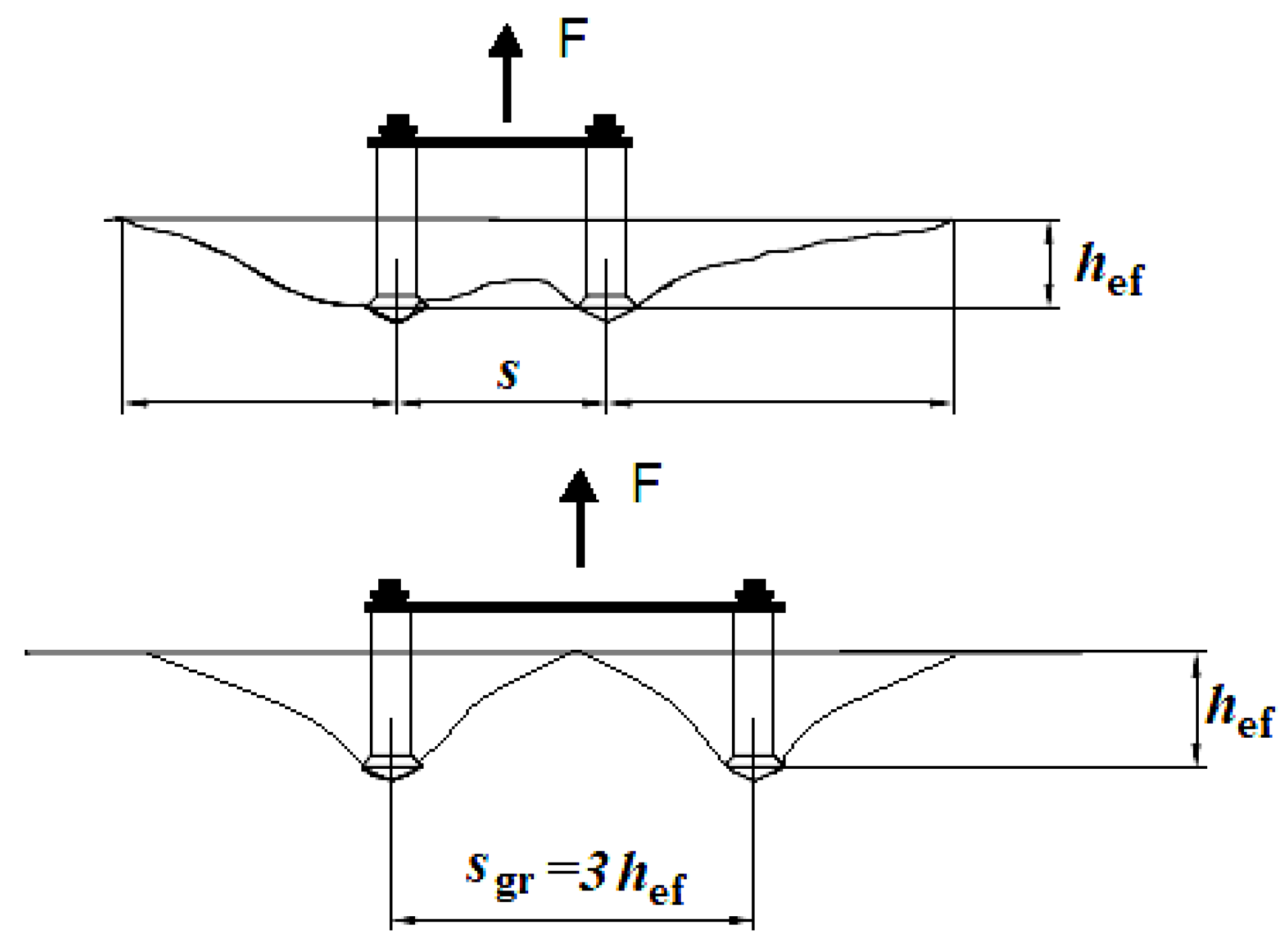
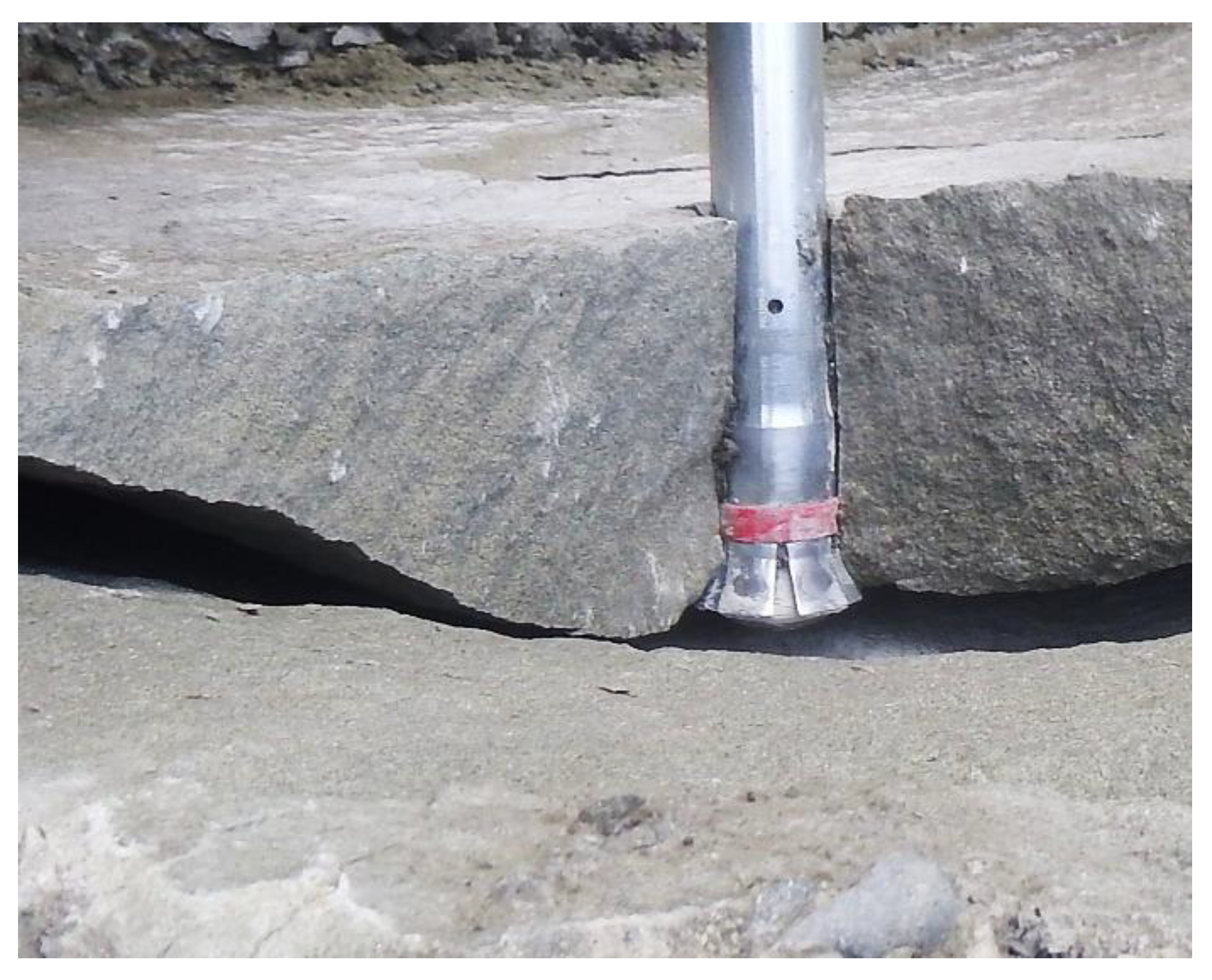
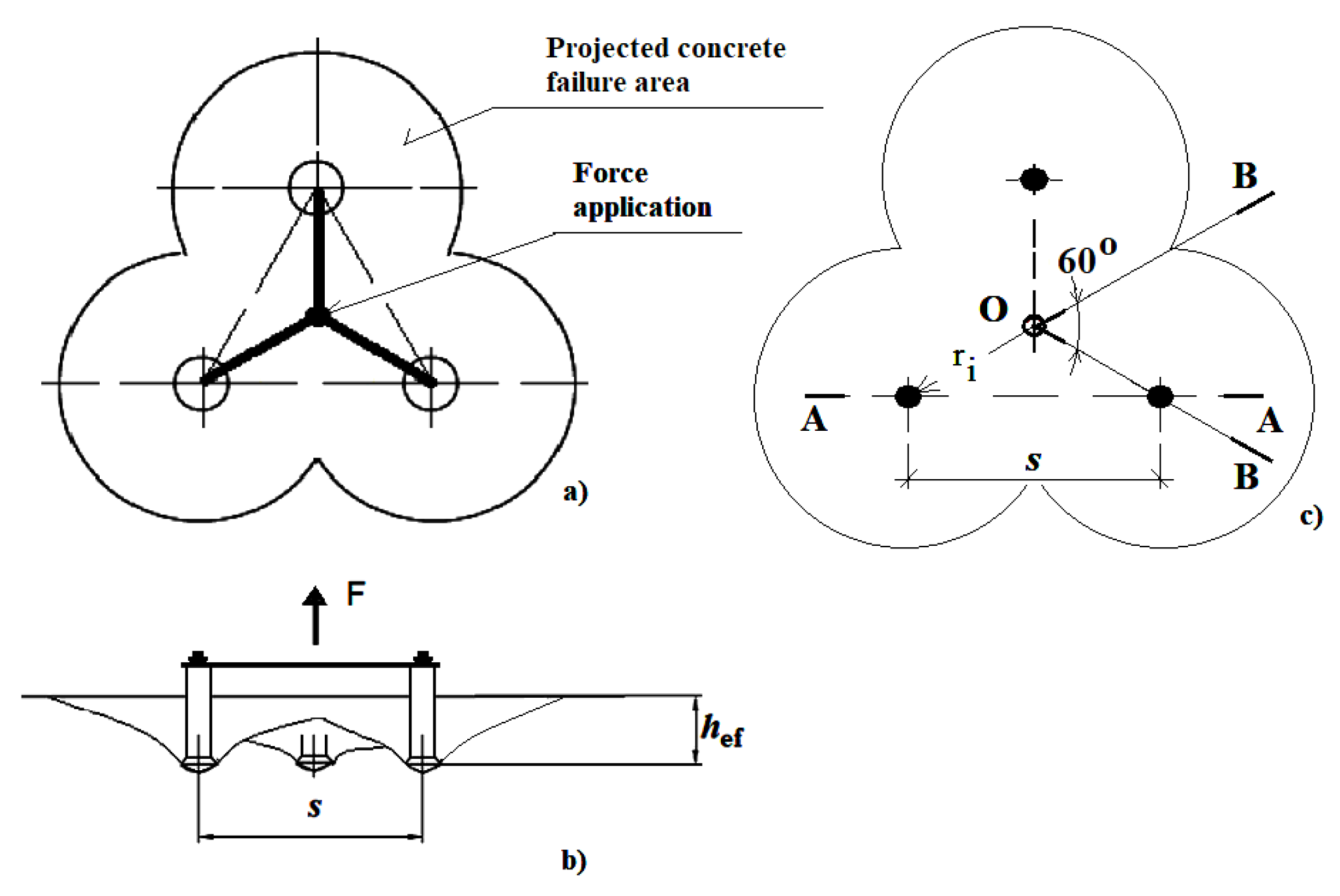







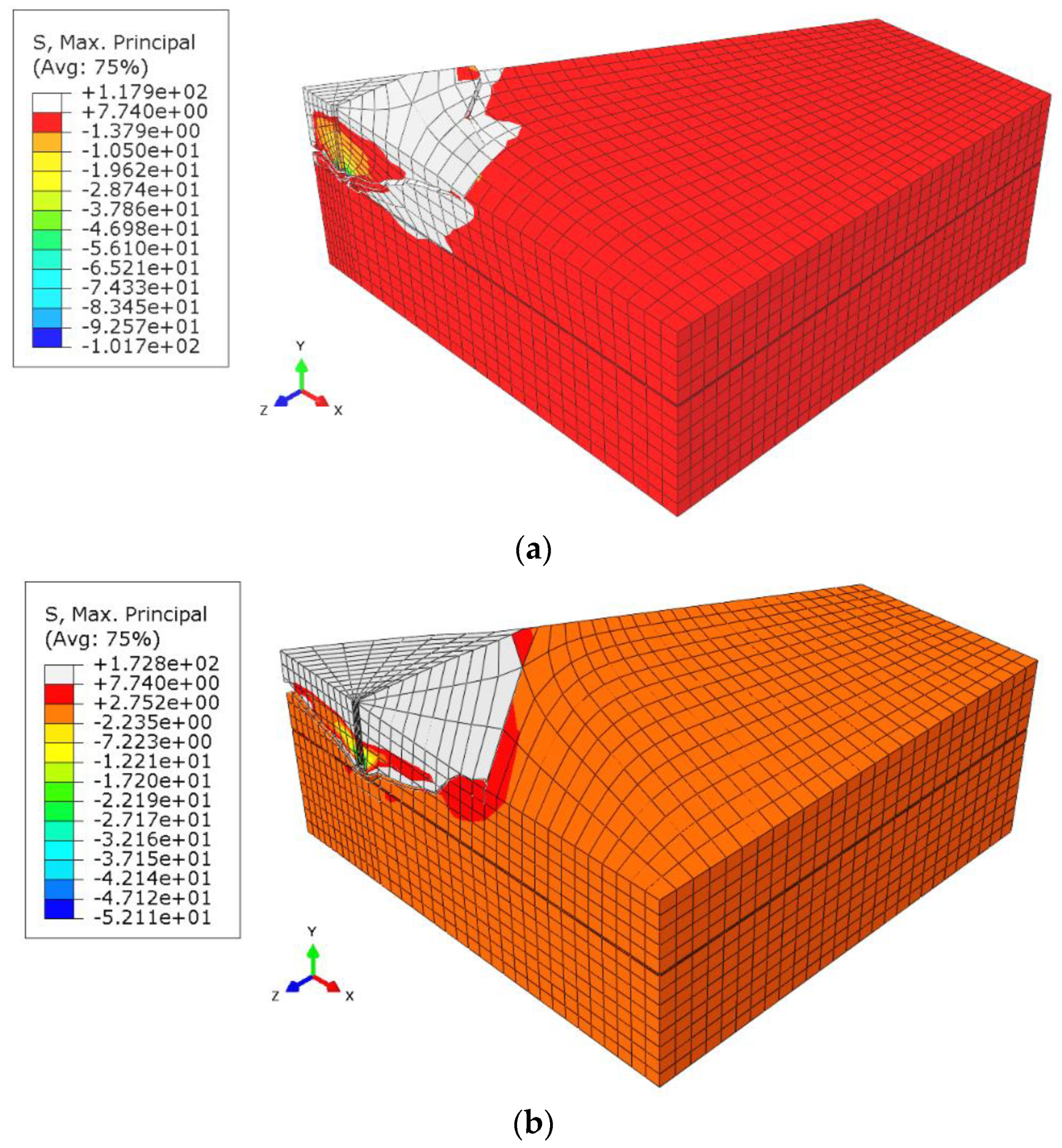
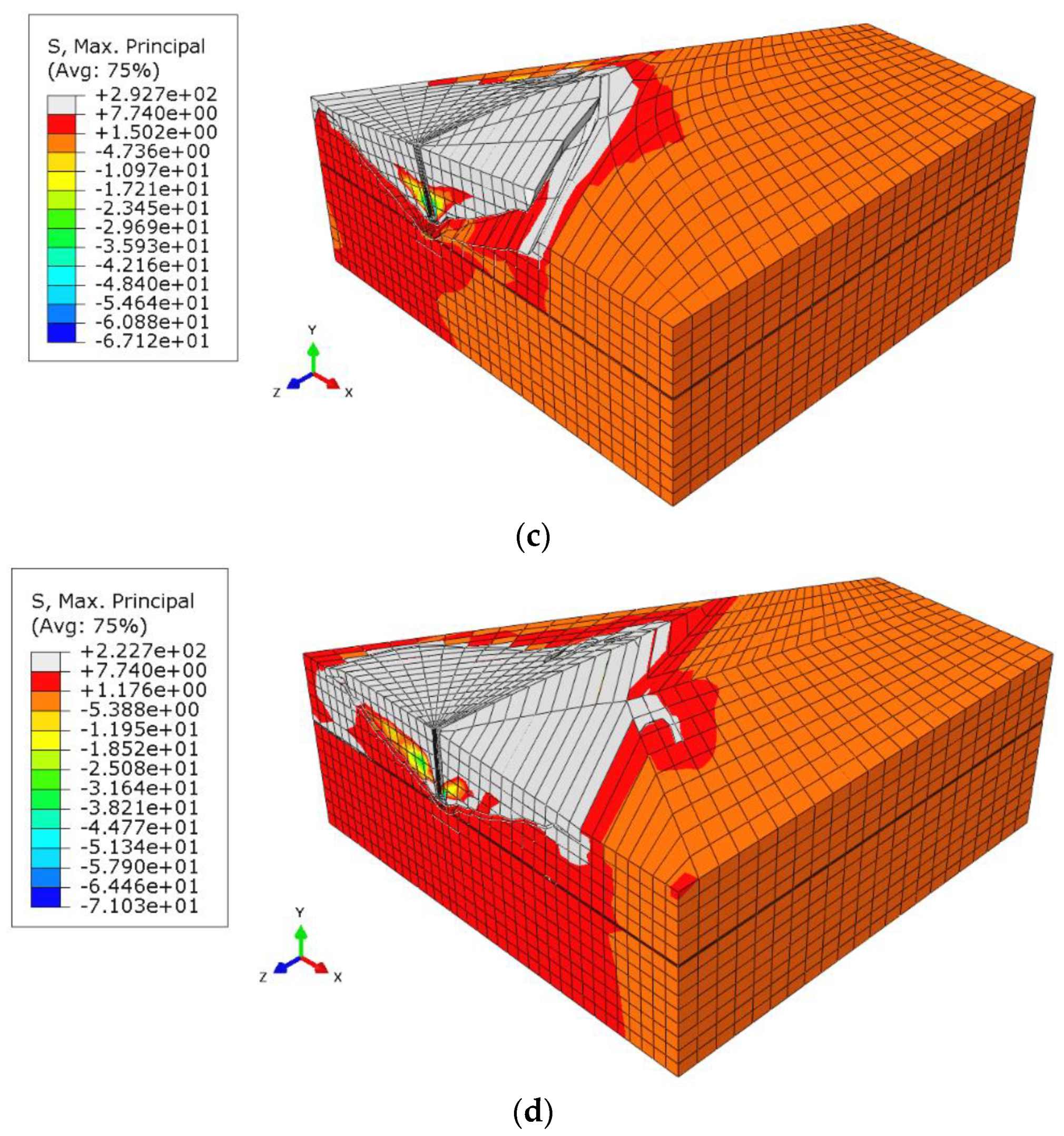
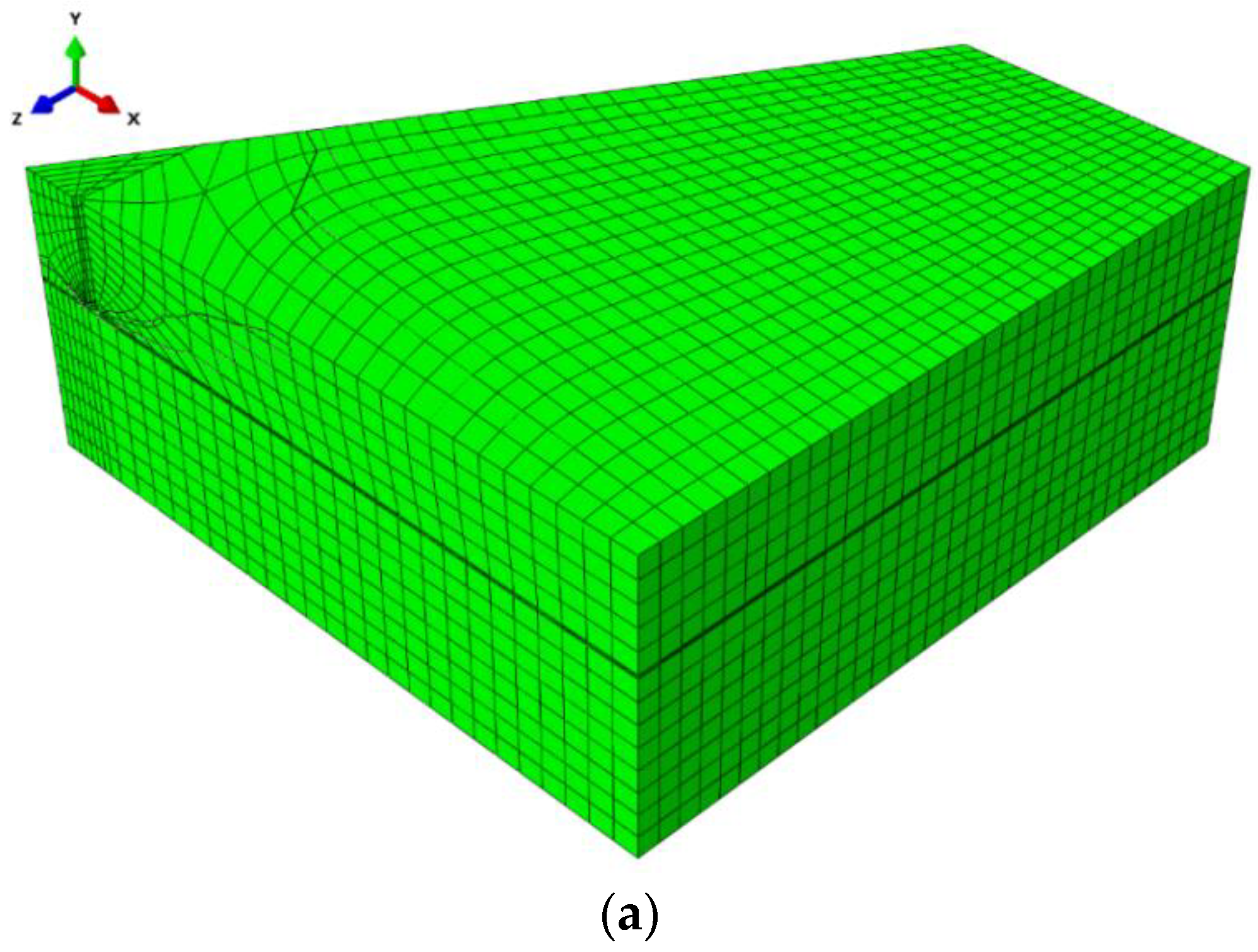
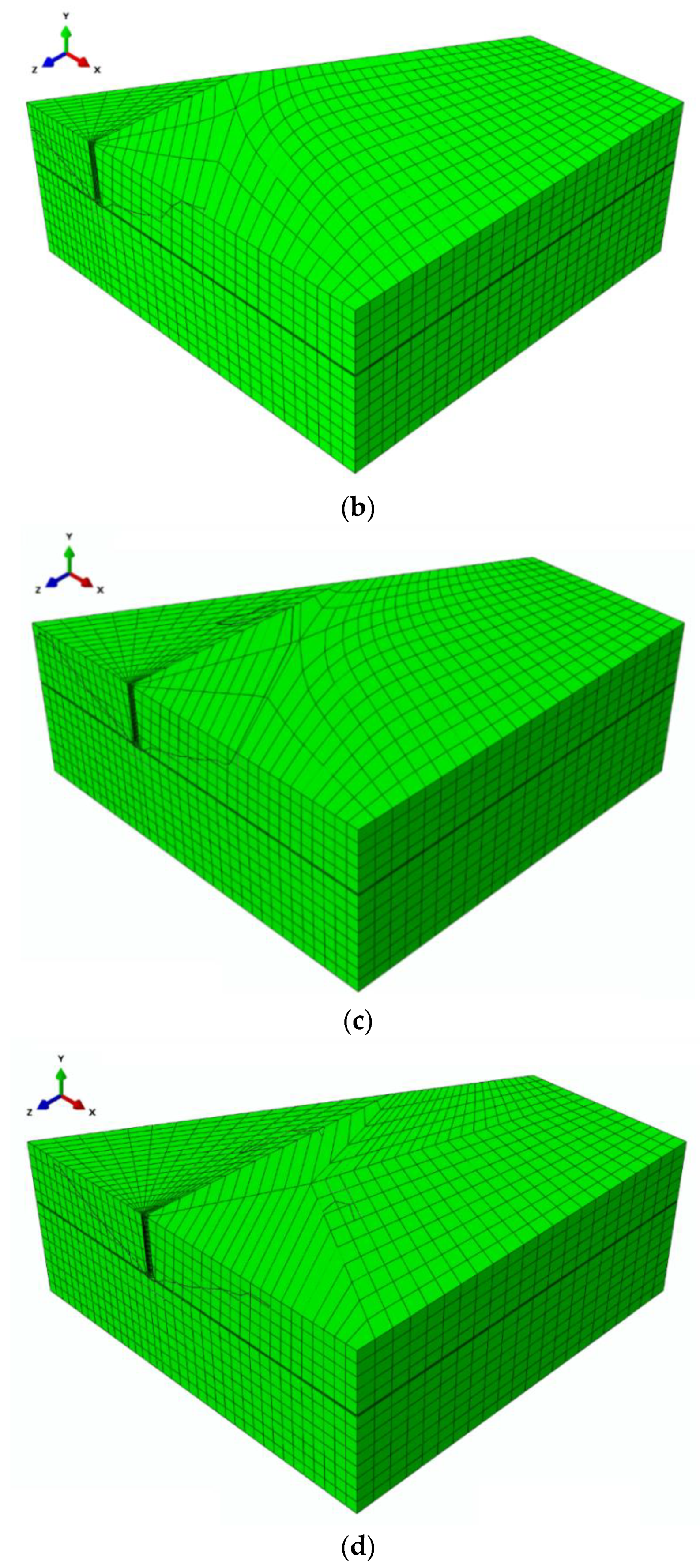
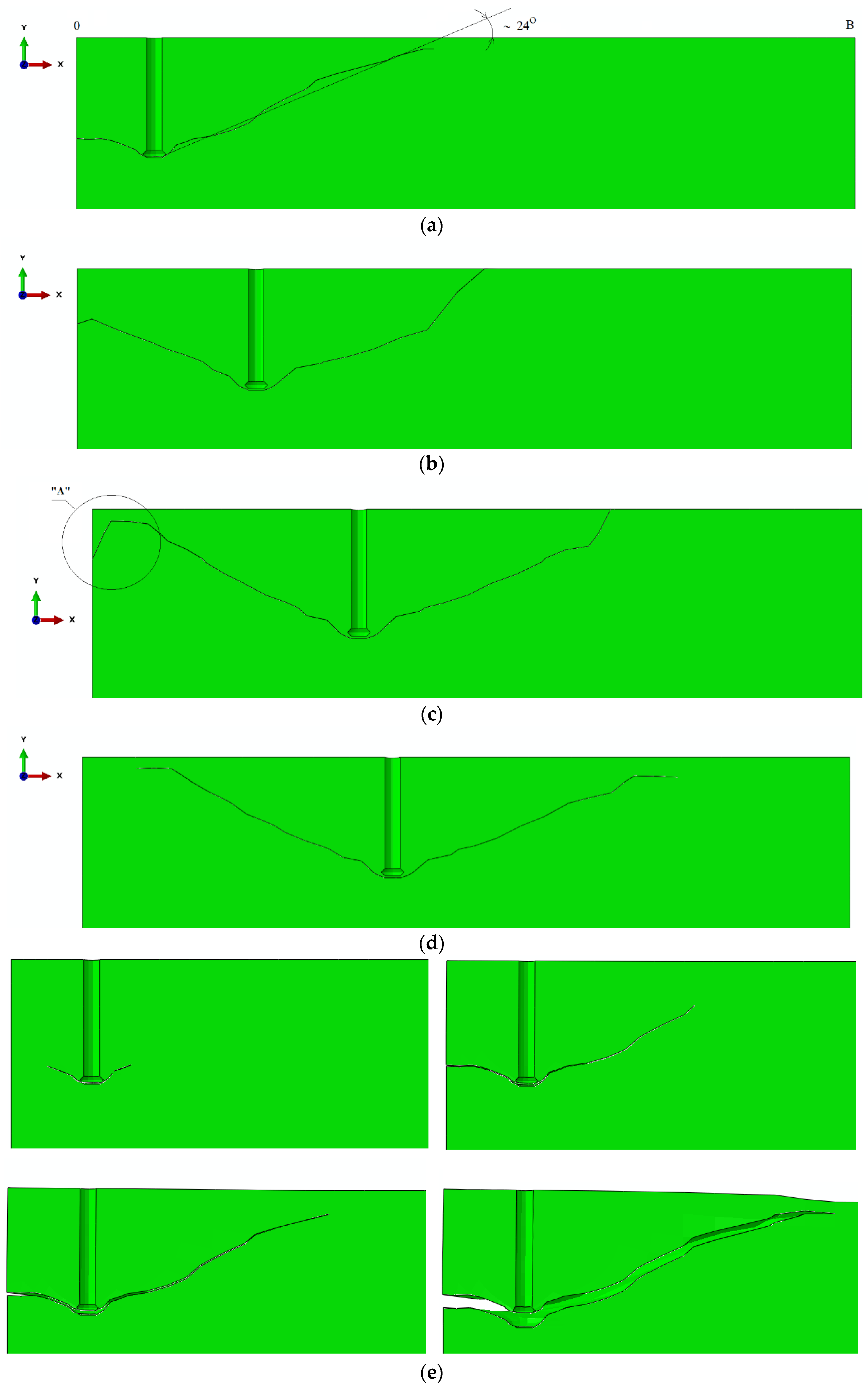
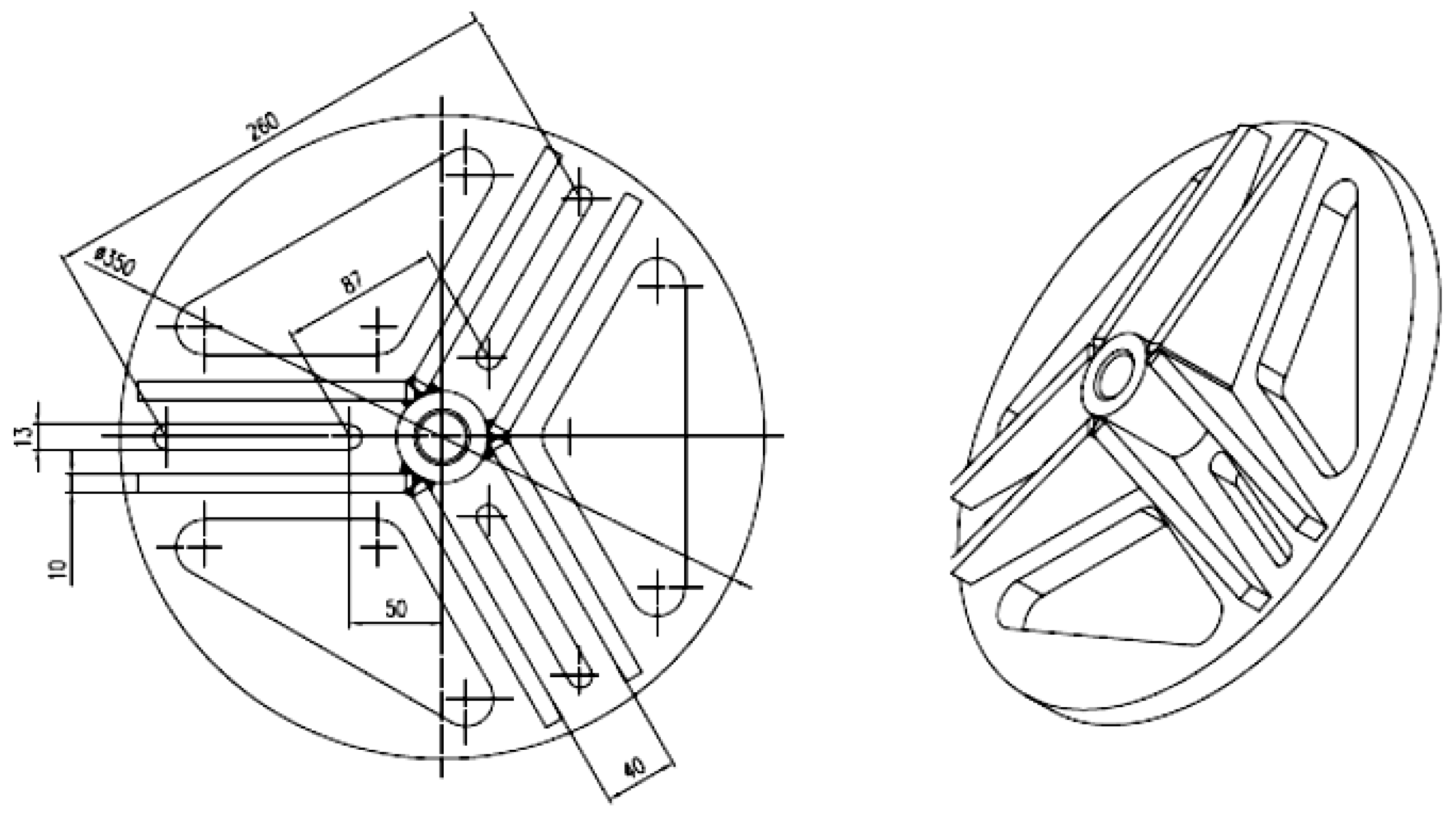
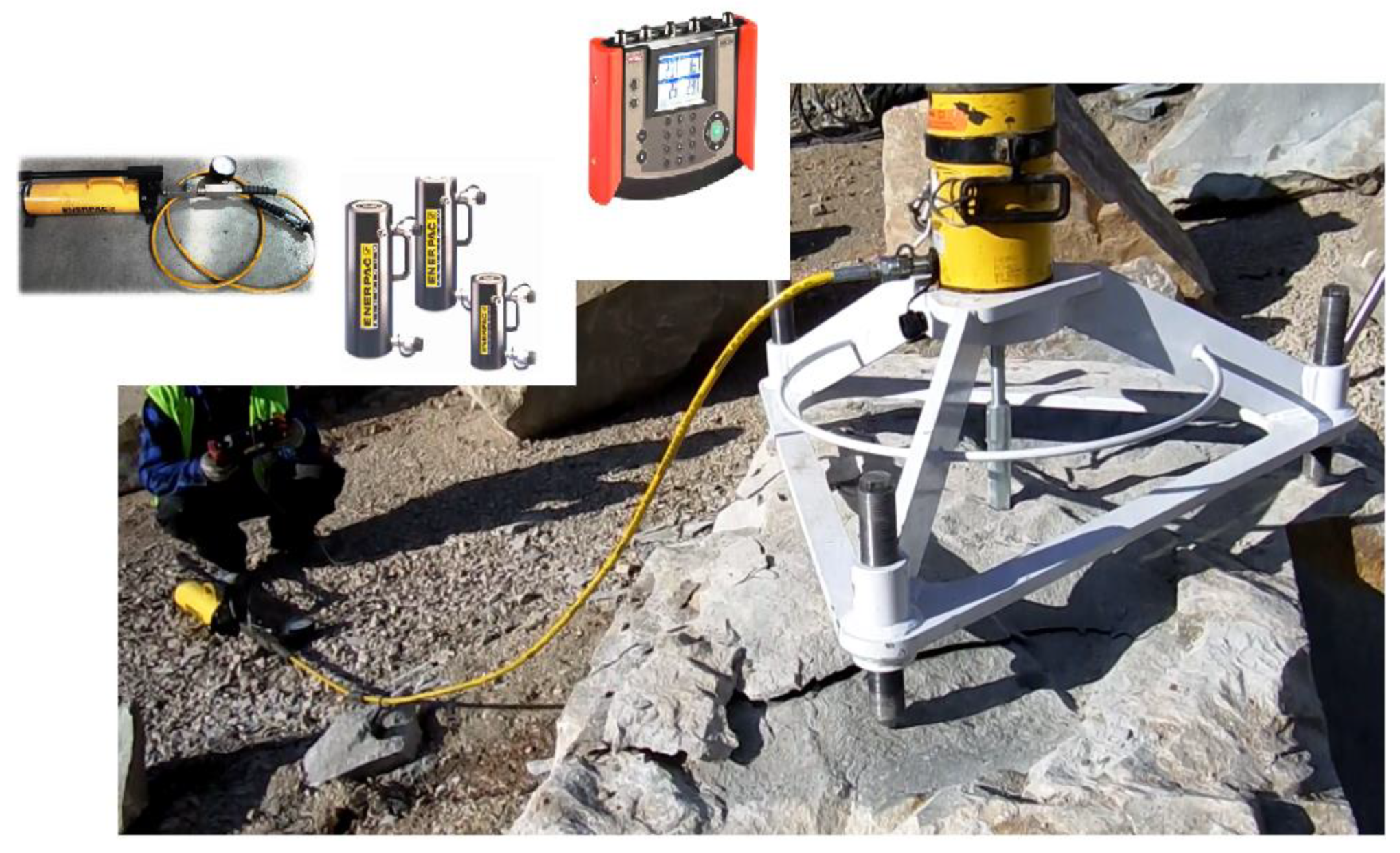
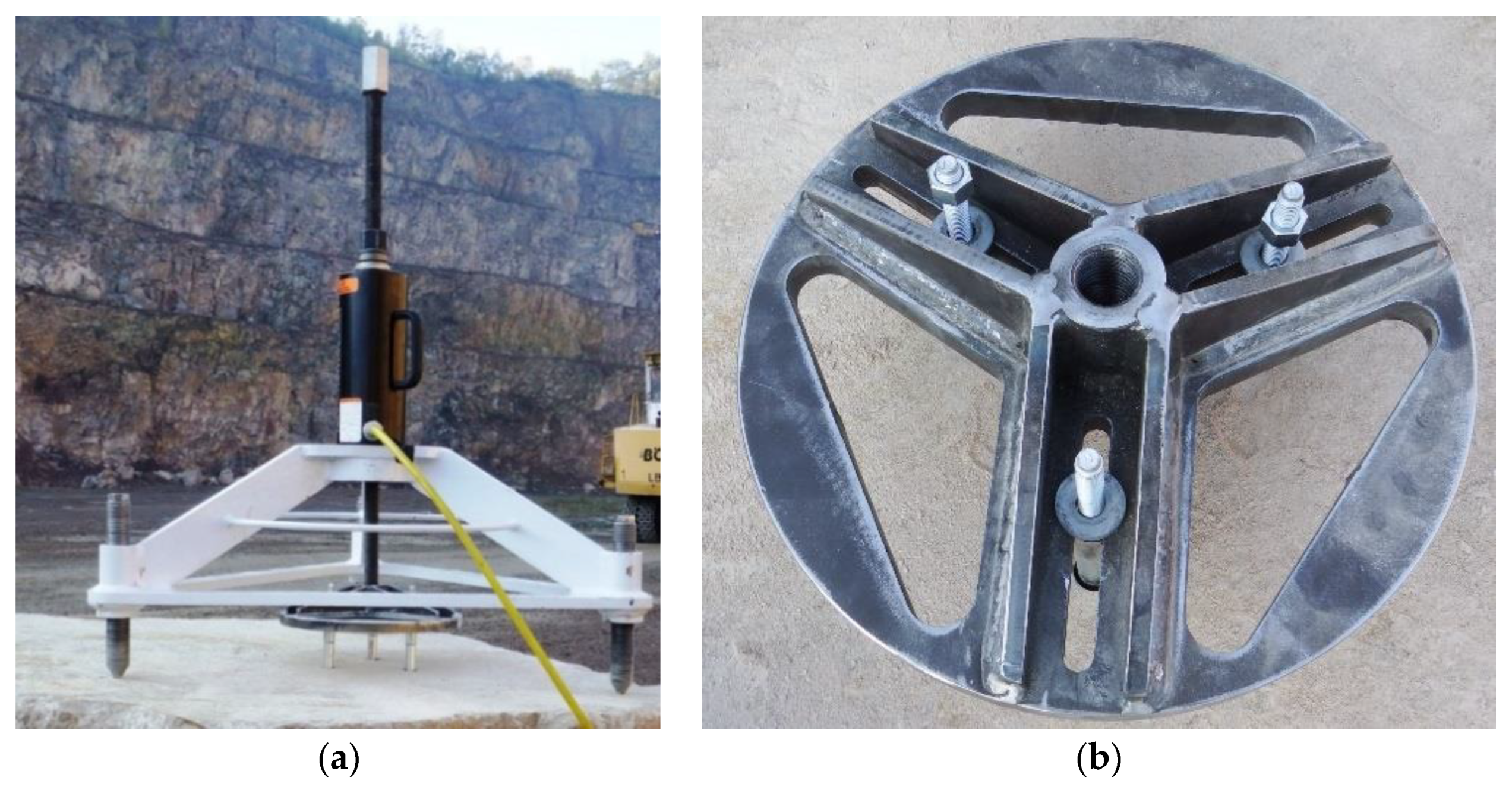



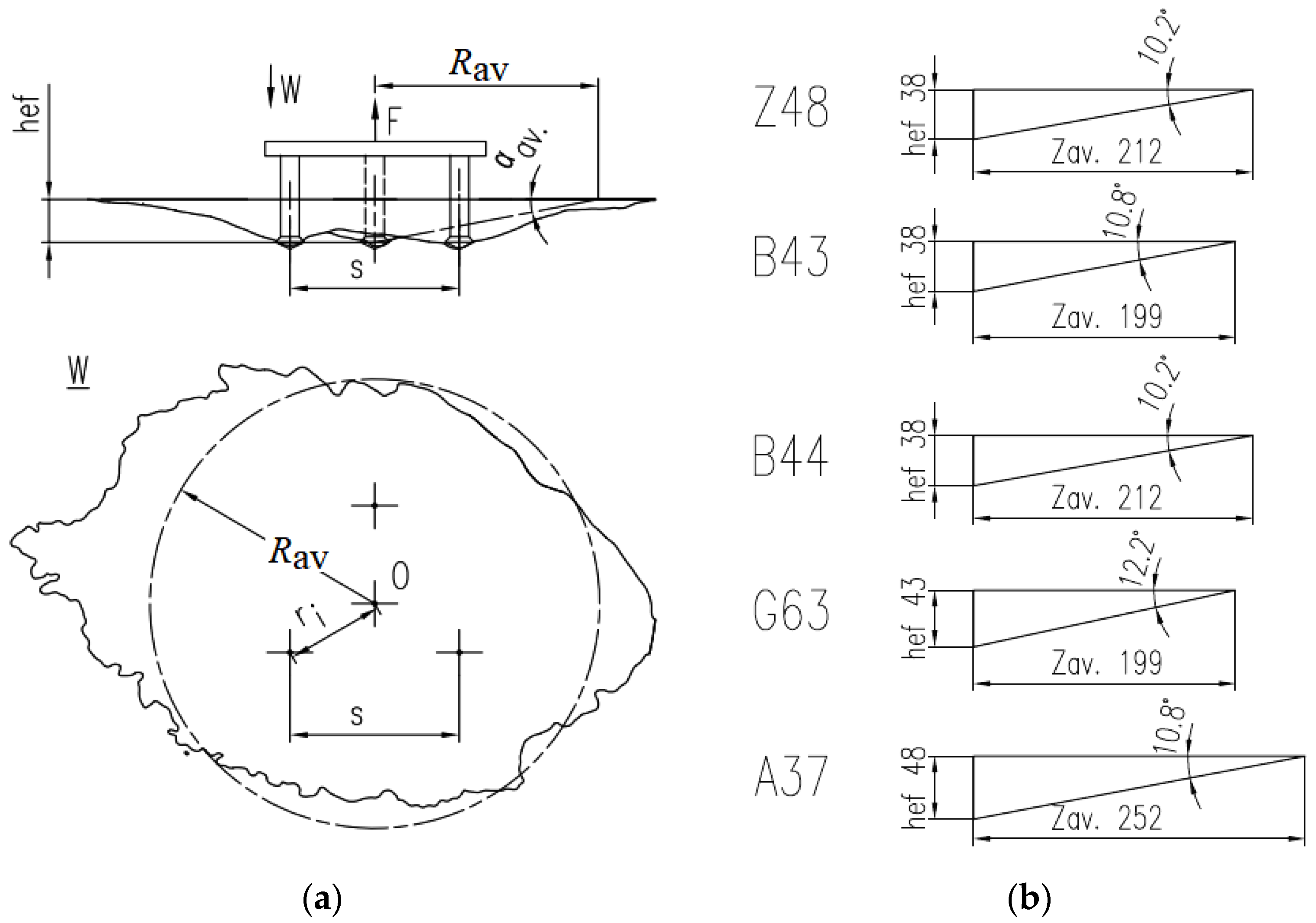
| Material Model | Linear Elastic |
|---|---|
| Young’s modulus (E) | 14.276 MPa |
| Poisson’s ratio (ν) | 0.247 |
| Tensile strength (ft) | 7.74 MPa |
| Damage criterion | “max. principal stress” |
| Damage evolution | type Energy, Softening: linear |
| Critical fracture energy rate (Gfc) | 0.335 N/mm |
| Damage stabilization | Cohesive with viscosity coefficient = 1 × 10−6 |
| Length | 1000 mm |
| Width | 1000 mm |
| Height | 400 mm |
| Model outline angle (BOB section) | 600 |
| Mine | fc (MPa) | Standard Deviation | ft (MPa) | Standard Deviation | k = fc/ft | ϕ (°) | C (MPa) | Rock | Description |
|---|---|---|---|---|---|---|---|---|---|
| Zalas | 106.5 | 23.86 | 5.9 | 1.91 | 18.1 | 54 | 8.6 | porphyry | Deck strongly undulating |
| Braciszów | 155.3 | 29.17 | 8 | 0.64 | 19.41 | 49.5 | 14.5 | sandstone | Sandstone strong, compact |
| Brenna | 58.8 | 9.29 | 3.9 | 1.17 | 15.1 | 53 | 6 | sandstone | Sandstone layered, weak |
| Guido | 97.4 | 25.52 | 6.2 | 0.94 | 15.7 | 49.6 | 11.9 | sandstone | Sandstone compact, medium strength |
| Test No. | hef [mm] | s [mm] | ri [mm] | s/hef | ri/hef | F [kN] | Rav. | αav | V [dm3] |
|---|---|---|---|---|---|---|---|---|---|
| Z48 | 38 | 135 | 78 | 3.6 | 2.1 | 155.86 | 212 | 10.2 | 2.08 |
| B43 | 38 | 125 | 72 | 3.3 | 1.9 | 148.19 | 199 | 10.8 | 2.68 |
| B44 | 38 | 140 | 81 | 3.7 | 2.1 | 204.40 | 212 | 10.2 | 3.21 |
| G63 | 43 | 125 | 72 | 2.9 | 1.7 | 206.96 | 199 | 12.2 | 3.22 |
| A37 | 48 | 190 | 110 | 4.0 | 2.3 | 114.98 | 252 | 10.8 | 4.00 |
Publisher’s Note: MDPI stays neutral with regard to jurisdictional claims in published maps and institutional affiliations. |
© 2020 by the authors. Licensee MDPI, Basel, Switzerland. This article is an open access article distributed under the terms and conditions of the Creative Commons Attribution (CC BY) license (http://creativecommons.org/licenses/by/4.0/).
Share and Cite
Jonak, J.; Karpiński, R.; Siegmund, M.; Wójcik, A.; Jonak, K. Analysis of the Rock Failure Cone Size Relative to the Group Effect from a Triangular Anchorage System. Materials 2020, 13, 4657. https://doi.org/10.3390/ma13204657
Jonak J, Karpiński R, Siegmund M, Wójcik A, Jonak K. Analysis of the Rock Failure Cone Size Relative to the Group Effect from a Triangular Anchorage System. Materials. 2020; 13(20):4657. https://doi.org/10.3390/ma13204657
Chicago/Turabian StyleJonak, Józef, Robert Karpiński, Michał Siegmund, Andrzej Wójcik, and Kamil Jonak. 2020. "Analysis of the Rock Failure Cone Size Relative to the Group Effect from a Triangular Anchorage System" Materials 13, no. 20: 4657. https://doi.org/10.3390/ma13204657
APA StyleJonak, J., Karpiński, R., Siegmund, M., Wójcik, A., & Jonak, K. (2020). Analysis of the Rock Failure Cone Size Relative to the Group Effect from a Triangular Anchorage System. Materials, 13(20), 4657. https://doi.org/10.3390/ma13204657





